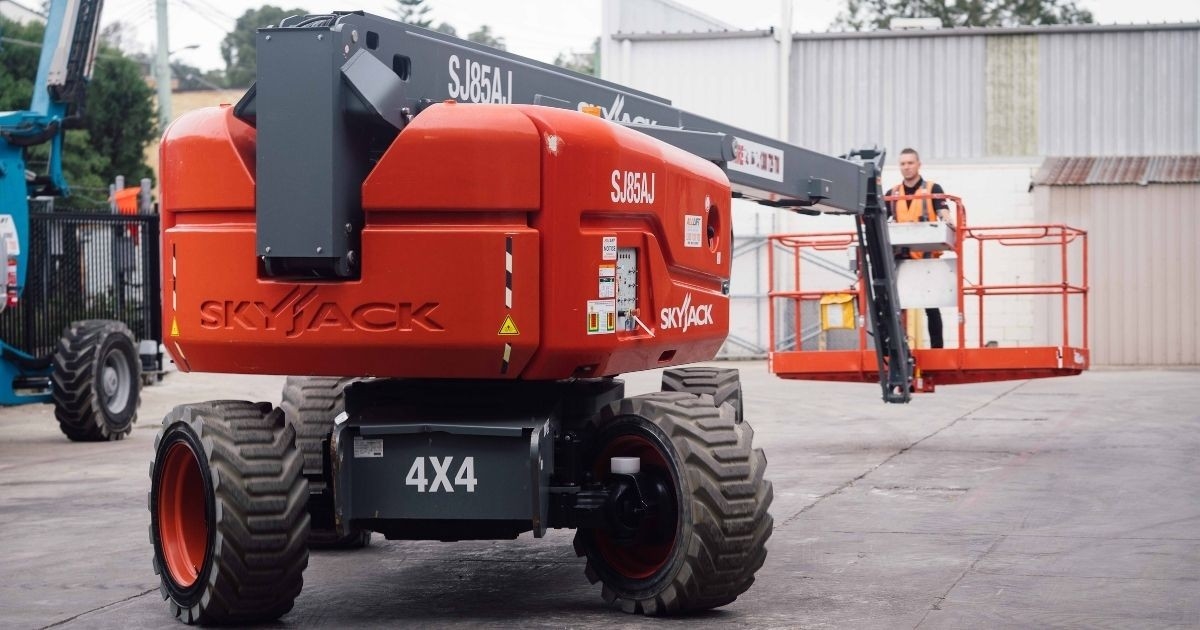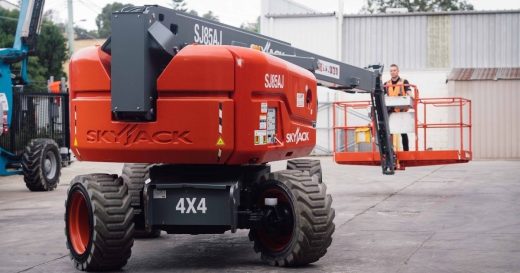Boom Lifts: Everything You Need to Know
Boom Lifts: Everything You Need to Know

A boom lift, also known as a cherry picker or man lift, is a type of aerial work platform that provides temporary access to inaccessible areas, often at height. It operates with a hydraulic arm that extends outward and upward, with a platform or bucket at the end for the operator. Boom lifts are commonly used in construction, warehouse management, maintenance, and other industries that require high-reach tasks.
Three Main Takeaways about Boom Lifts:
- Safety: Boom lifts present significant safety concerns. Operators need to be properly trained to handle these machines, which are large, heavy, and capable of causing serious harm if misused.
- Versatility: One of the most significant advantages of boom lifts is their versatility. They’re extensively used in construction, maintenance, film, and many more industries. Their extendable arm and bucket allow users to access hard-to-reach areas, making them invaluable for various tasks.
- Maintenance: Routine and proper maintenance is key to prolonging the lifespan of a boom lift. Regular inspection from certified professionals is necessary to keep the system performing optimally and prevent accidents.
|
Featured Partner for Equipment Parts
on EquipmentShares’s website
|
The Significance of a Boom Lift
A boom lift, also known as a cherry picker or man lift, is a critical piece of equipment in construction and maintenance due to its functionality and safety features. It’s primarily used to safely lift workers to elevated, hard-to-reach areas, reducing the risk of accidents that ladders or scaffolding might pose. A boom lift promotes efficiency as it can smoothly maneuver and reach heights with versatility and precision, preventing delays in tasks such as painting, cleaning, repairing, or installing fixtures.
Without the boom lift’s lifting and reaching capabilities, certain jobs would be impossible to complete or take considerably more time and effort. Therefore, the boom lift is significant in various industries and is often vital for ensuring project success and safety.
Safety Tips with Boom Lifts
Operating a boom lift requires careful attention to safety to prevent accidents and ensure the well-being of operators and others in the vicinity. Here are some safety tips for operating a boom lift:
- Proper Training: Only trained and certified operators should operate a boom lift. Comprehensive training should cover equipment operation, safety procedures, and emergency protocols.
- Pre-Operation Inspection: Before using the boom lift, conduct a thorough pre-operation inspection to check for any damage, leaks, or malfunctions. Ensure all safety devices, including harnesses and guardrails, are in good working condition.
- Stable Ground: Set up the boom lift on firm and level ground. Use outriggers and stabilizers as needed to increase stability.
- Weight Limit: Never exceed the boom lift’s maximum weight capacity. Consider the combined weight of operators, tools, and equipment to stay within the safe limits.
- Harness and Personal Protective Equipment (PPE): Always wear a full-body harness and attach it to the boom lift’s designated anchor point. Additionally, wear appropriate PPE, including a hard hat, safety glasses, gloves, and high-visibility clothing.
- Clear Work Area: Ensure the work area is clear of obstacles and people. Keep bystanders and non-essential personnel at a safe distance during operation.
- Weather Conditions: Avoid operating the boom lift during adverse weather conditions such as high winds, storms, or lightning.
- Smooth Movements: Make slow and controlled movements with the boom lift. Avoid abrupt starts, stops, or rapid movements to maintain stability.
- Be Mindful of Overhead Hazards: Watch for overhead obstacles such as power lines, branches, or other structures. Maintain a safe distance from these hazards.
- Stay on the Platform: Never stand or climb on the guardrails or attempt to reach outside the platform while the boom lift operates.
- Communication: Establish clear communication between the operator and ground personnel. Use hand signals or two-way radios to convey important information.
- Emergency Procedures: Familiarize yourself with the emergency procedures for the specific boom lift model you are operating. Know how to lower the platform in case of power failure or other emergencies.
- Battery/Energy Source Safety: If batteries power the boom lift, follow the manufacturer’s guidelines for charging, storage, and handling of batteries. For fuel-powered lifts, handle fuel safely and keep fuel containers away from ignition sources.
- Travel with Boom Lowered: Lower the boom and secure all equipment before moving the lift to a new location. Avoid moving the boom lift with the platform raised.
- Parking and Storage: When not in use, park the boom lift in a designated area and engage the parking brake. Store the boom lift in a secure location.
How Boom Lifts are Used
A boom lift, a key construction and maintenance equipment piece, is critical in various tasks requiring high-reach applications. It is designed to help workers safely reach elevated and hard-to-reach areas, thus enhancing efficiency and productivity.
A boom lift is typically used for construction, window cleaning, painting, installation, tree trimming, and many other tasks involving high areas. Not only does it maximize safety by reducing the risk of falls, but it also expedites the job by providing a stable platform to work from. The boom lift is more than just a high-reach device. It’s an essential tool that optimizes operational efficiency by enabling tasks to be completed quickly and effectively on a large scale.
One particular advantage is its versatility and flexibility, maneuvering in various directions – up, down, and sideways. Bigger versions of this equipment can extend to great heights, with some models reaching up to 185 feet. It’s important to note that using this equipment requires proper training to ensure the safety of operators and those in the immediate vicinity.
|
Featured Partner for Equipment Parts
on EquipmentShares’s website
|
Examples of Boom Lift Use
- Building Maintenance and Repairs: Maintenance crews often employ boom lifts to repair or clean the exterior of tall residential or commercial buildings. For example, if some window panes of a high-rise building need to be replaced or if some outdoor light fixtures need to be fixed, a boom lift would be employed to bring the crew to the appropriate height.
- Construction Industry: In a new high-rise structure construction project, boom lifts might transport materials and workers to higher levels of scaffolding. They can lift heavy materials to higher floors, assist with installing windows or ventilation systems, and provide a secure platform for construction workers operating at heights.
- Tree Care Services: Tree surgeons often use boom lifts to trim tall trees. A tree surgeon can safely reach the desired height using a boom lift and carry out their work effectively. This process maintains the tree’s health and ensures the safety of people and property beneath it.
Differences between Boom Lift and Scissor Lift
| Feature | Boom Lift | Scissor Lift |
| Movement | Articulating or Telescopic | Vertical only |
| Reach | High reach, often up to 185 feet | Lower reach, typically up to 40-50 feet |
| Direction | Can extend in all directions (up, down, sideways) | Can only move vertically |
| Platform Size | Relatively larger platform | Smaller platform |
| Stability | Requires outriggers for stability | Self-leveling, stable on flat surfaces |
| Use Cases | Construction, maintenance, window cleaning, tree trimming | Indoor maintenance, installation, and tasks in confined spaces |
| Maneuverability | Less maneuverable due to outriggers and larger size | Highly maneuverable in tight spaces |
| Typical Applications | Outdoor tasks with the need for high reach and flexibility | Indoor maintenance, warehouse stocking, and low to mid-height tasks |
| Transportation | May require special transport due to size | Can be easily moved with standard trailers or trucks |
| Cost | Generally more expensive | Generally more affordable |
|
Featured Partner for Equipment Parts
on EquipmentShares’s website
|
Frequently Asked Questions (FAQ)
Q: What is a boom lift?
A: A boom lift, also known as a cherry picker or man lift, is a type of aerial work platform that allows workers to reach high or inaccessible areas. It has a platform or bucket at the end of a hydraulic lifting system attached to a grounded base.
Check out boom lift parts from our featured partner – EquipmentShare!
Q: How high can a boom lift reach?
A: The reach of a boom lift greatly depends on the specific model, but they can typically reach heights anywhere from 30 feet to 180 feet.
Q: What is the difference between a boom lift and a scissor lift?
A: A scissor lift can only move vertically and is limited to working directly overhead, whereas a boom lift can extend in all directions, providing more flexibility and reach.
Q: Who can operate a boom lift?
A: Only trained and certified professionals can operate a boom lift due to safety precautions. Operator certification usually involves both classroom and hands-on training.
Q: What safety precautions should be observed when using a boom lift?
A: Operators should always wear a harness, ensure the lift is on stable ground before ascending, keep the work area clear of people and obstacles, and never exceed the weight limit.
Q: Can boom lifts be used indoors?
A: Yes, boom lifts can be used indoors, provided there is sufficient space. However, certain boom lifts may require ventilation due to emissions.
Q: What types of tasks are boom lifts used for?
A: Boom lifts are commonly used in construction, maintenance, warehouse stocking, painting, tree work, and any tasks that require reaching high or inaccessible areas.
Q: Which type of boom lift should I use for my project?
A: It depends on the specific requirements of your project – the height, reach, indoor/outdoor setting and weight limit would determine the type of boom lift required.
Q: Is the boom lift electric or diesel-powered?
A: Boom lifts come in both electric and diesel models. Electric ones are quieter and better for the environment and are typically used indoors, while diesel models are used for construction where more power might be needed.
Image Credit: EquipmentShare; Thank you!
The post Boom Lifts: Everything You Need to Know appeared first on ReadWrite.
(9)


